Control of transcriptional elongation and cotranscriptional histone modification by the yeast BUR kinase substrate Spt5
- PMID: 19365074
- PMCID: PMC2678430
- DOI: 10.1073/pnas.0806302106
Control of transcriptional elongation and cotranscriptional histone modification by the yeast BUR kinase substrate Spt5
Abstract
Elongation by RNA polymerase II (RNAPII) is a finely regulated process in which many elongation factors contribute to gene regulation. Among these factors are the polymerase-associated factor (PAF) complex, which associates with RNAPII, and several cyclin-dependent kinases, including positive transcription elongation factor b (P-TEFb) in humans and BUR kinase (Bur1-Bur2) and C-terminal domain (CTD) kinase 1 (CTDK1) in Saccharomyces cerevisiae. An important target of P-TEFb and CTDK1, but not BUR kinase, is the CTD of the Rpb1 subunit of RNAPII. Although the essential BUR kinase phosphorylates Rad6, which is required for histone H2B ubiquitination on K123, Rad6 is not essential, leaving a critical substrate(s) of BUR kinase unidentified. Here we show that BUR kinase is important for the phosphorylation in vivo of Spt5, a subunit of the essential yeast RNAPII elongation factor Spt4/Spt5, whose human orthologue is DRB sensitivity-inducing factor. BUR kinase can also phosphorylate the C-terminal region (CTR) of Spt5 in vitro. Like BUR kinase, the Spt5 CTR is important for promoting elongation by RNAPII and recruiting the PAF complex to transcribed regions. Also like BUR kinase and the PAF complex, the Spt5 CTR is important for histone H2B K123 monoubiquitination and histone H3 K4 and K36 trimethylation during transcription elongation. Our results suggest that the Spt5 CTR, which contains 15 repeats of a hexapeptide whose consensus sequence is S[T/A]WGG[A/Q], is a substrate of BUR kinase and a platform for the association of proteins that promote both transcription elongation and histone modification in transcribed regions.
Conflict of interest statement
The authors declare no conflict of interest.
Figures




Similar articles
-
Phosphorylation of the transcription elongation factor Spt5 by yeast Bur1 kinase stimulates recruitment of the PAF complex.Mol Cell Biol. 2009 Sep;29(17):4852-63. doi: 10.1128/MCB.00609-09. Epub 2009 Jul 6. Mol Cell Biol. 2009. PMID: 19581288 Free PMC article.
-
Biochemical Analysis of Yeast Suppressor of Ty 4/5 (Spt4/5) Reveals the Importance of Nucleic Acid Interactions in the Prevention of RNA Polymerase II Arrest.J Biol Chem. 2016 May 6;291(19):9853-70. doi: 10.1074/jbc.M116.716001. Epub 2016 Mar 4. J Biol Chem. 2016. PMID: 26945063 Free PMC article.
-
The C-terminal repeat domain of Spt5 plays an important role in suppression of Rad26-independent transcription coupled repair.J Biol Chem. 2010 Feb 19;285(8):5317-26. doi: 10.1074/jbc.M109.082818. Epub 2009 Dec 30. J Biol Chem. 2010. PMID: 20042611 Free PMC article.
-
The CDK9-SPT5 Axis in Control of Transcription Elongation by RNAPII.J Mol Biol. 2025 Jan 1;437(1):168746. doi: 10.1016/j.jmb.2024.168746. Epub 2024 Aug 13. J Mol Biol. 2025. PMID: 39147127 Review.
-
Bur1/Bur2 and the Ctk complex in yeast: the split personality of mammalian P-TEFb.Cell Cycle. 2006 May;5(10):1066-8. doi: 10.4161/cc.5.10.2769. Epub 2006 May 15. Cell Cycle. 2006. PMID: 16721054 Review.
Cited by
-
Ubiquitous transcription factors display structural plasticity and diverse functions: NusG proteins - Shifting shapes and paradigms.Bioessays. 2015 Mar;37(3):324-34. doi: 10.1002/bies.201400177. Epub 2015 Jan 15. Bioessays. 2015. PMID: 25640595 Free PMC article. Review.
-
Spt6 directly interacts with Cdc73 and is required for Paf1 complex occupancy at active genes in Saccharomyces cerevisiae.Nucleic Acids Res. 2023 Jun 9;51(10):4814-4830. doi: 10.1093/nar/gkad180. Nucleic Acids Res. 2023. PMID: 36928138 Free PMC article.
-
Separable functions of the fission yeast Spt5 carboxyl-terminal domain (CTD) in capping enzyme binding and transcription elongation overlap with those of the RNA polymerase II CTD.Mol Cell Biol. 2010 May;30(10):2353-64. doi: 10.1128/MCB.00116-10. Epub 2010 Mar 15. Mol Cell Biol. 2010. PMID: 20231361 Free PMC article.
-
DSIF, the Paf1 complex, and Tat-SF1 have nonredundant, cooperative roles in RNA polymerase II elongation.Genes Dev. 2009 Dec 1;23(23):2765-77. doi: 10.1101/gad.1834709. Genes Dev. 2009. PMID: 19952111 Free PMC article.
-
In vitro analysis of RNA polymerase II elongation complex dynamics.Genes Dev. 2019 May 1;33(9-10):578-589. doi: 10.1101/gad.324202.119. Epub 2019 Mar 7. Genes Dev. 2019. PMID: 30846429 Free PMC article.
References
-
- Saunders A, Core LJ, Lis JT. Breaking barriers to transcription elongation. Nat Rev Mol Cell Biol. 2006;7:557–567. - PubMed
-
- Peterlin BM, Price DH. Controlling the elongation phase of transcription with P-TEFb. Mol Cell. 2006;23:297–305. - PubMed
-
- Price DH. Poised polymerases: On your mark… get set… go! Mol Cell. 2008;30:7–10. - PubMed
-
- Phatnani HP, Greenleaf AL. Phosphorylation and functions of the RNA polymerase II CTD. Genes Dev. 2006;20:2922–2936. - PubMed
Publication types
MeSH terms
Substances
LinkOut - more resources
Full Text Sources
Molecular Biology Databases
Research Materials

